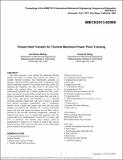Pulsed Heat Transfer for Thermal Maximum Power Point Tracking
Author(s)
McKay, Ian; Wang, Evelyn
Downloadv06bt07a032-imece2013-62998.pdf (1.935Mb)
PUBLISHER_POLICY
Publisher Policy
Article is made available in accordance with the publisher's policy and may be subject to US copyright law. Please refer to the publisher's site for terms of use.
Terms of use
Metadata
Show full item recordAbstract
This paper presents a new method for enhancing thermal energy harvesting via pulsed heat transfer. By acting as a variable thermal resistance that theoretically generates no entropy, a pulsed thermal connection allows calibration of the effective thermal resistance of an energy harvesting system. By adjusting the frequency and duty cycle of the pulsed heat transfer, the method allows an energy harvester to be continuously optimized for a variable incident heat flux. In this paper, the analysis of a generalized model shows how the pulse strategy theoretically allows any heat engine-heat sink pair to work at the same power and efficiency as a 1:1 thermal resistance-matched engine-heat sink pair of equal or greater total thermal resistance. Experiments with a mechanical thermal switch validate this model, and show how the pulse strategy can improve the efficiency of a system with equal engine and heat sink thermal resistances by over 80% with no increase in the hot-side maximum temperature, although at reduced total power. At a 1:2 engine-sink resistance ratio, the improvement can simultaneously exceed 60% in power and 15% in efficiency. The thermal pulse strategy could be implemented to improve of a variety of systems that convert thermal energy, from waste heat harvesters to the radioisotope power systems on many spacecraft. Topics: Heat transfer
Date issued
2013-11Department
Massachusetts Institute of Technology. Department of Mechanical EngineeringJournal
Proceedings of the ASME 2013 International Mechanical Engineering Congress and Exposition
Publisher
ASME International
Citation
McKay, Ian Salmon, and Evelyn N. Wang. “Pulsed Heat Transfer for Thermal Maximum Power Point Tracking.” Proceedings of the ASME 2013 International Mechanical Engineering Congress and Exposition, 15-21 November, 2013, San Diego, California, USA, ASME, 2013. © 2013 by ASME
Version: Final published version
ISBN
978-0-7918-5629-1